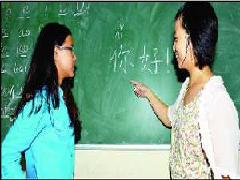孟买的第三代华人瞄准全球工作,学习中文
MUMBAI: "Mera chehra dekh ke price mat bolo," says Sylivia Chang, an interior designer and mother of two, while shop on Mumbai's streets. She's part of the city's minuscule population estimated at around 4,000 people. Many, like Sylvia, have lived in India for generations. She speaks English, Hindi, Marathi, Gujarati and a bit of Bengali. But her features ensure she's routinely called Nepali or North East Indian. "I get to skip queues in government offices as they think I'm a foreigner. They are surprised when I start speaking Hindi," she laughs.
South Mumbai resident Kitlin Chang (20) says shopkeepers on Colaba Causeway put on an accent when she passes by. But shopkeepers in Shanghai are far worse, and shoo her away when they figure out she can't speak Mandarin.
Sylivia Chang是室内设计师,两个孩子的母亲,她是孟买大约4000人组成的华人群体中的一员。许多华人像Sylvia一样世世代代生活在印度。她说的是英语、印地语、马拉地语、古吉拉特语,还会说一点孟加拉语。但是她的外貌特征常常被人说是尼泊尔人或者印度东北人。“在政府机构办事时,我被认为是外国人,可以插队。我一说印地语,他们就吃惊了。”她笑着说。
南孟买居民Kitlin Chang(20岁)说,她路过克拉巴街时,店主对她说话会刻意带有口音,而在上海,那些店主更甚,当发现她不会说中文时,就把她嘘走了。

"Where are you from?" is a question she's frequently asked in India. Born and bred in Mumbai, this third generation settler tells people her parents are from Kolkata and Mumbai. The questions persist. People want to know where she's 'actually' from. The questions tire her.
A bid to connect with her roots is part of the reason she recently joined Mandarin classes in Mumbai conducted by Inchin Closer, an India- language and cultural consultancy.
“你来自哪里?”是她在印度经常被问及的问题。出生在孟买,长大在孟买,这个第三代华人对别人说她父母分别来自加尔各答和孟买。这个问题一直有人在问。人们想知道她到底来自哪里,问得让她厌倦了。
为了寻根,是她最近在孟买参加中文课程的原因。
But sentiment isn't the only inspiration for learning Mandarin. Like many Indians, she hopes Mandarin will give her a competitive edge in the global job market where is an important player.
"I'm currently working at an IT start-up that collaborates with a manufacturer. I recently attended a job expo in Mumbai attended by many , one of whom began talking to me in Mandarin. I couldn't understand what she was saying. I wish I did," says Kitlin.
While Kitlin speaks a smattering of Hakka, native to the South region her family comes from, Sylvia speaks Hupeh, another provincial language. Both feel Mandarin, like Hindi, would give them access to much larger swathes of the country.
然而情感并非是学习中文的唯一动力。跟许多印度人一样,她希望中文能给她在全球就业市场上获得竞争优势,而在其中是重要的一员。
“目前,我在一家IT创业公司上班,这家公司与厂商合作。我最近在孟买参加了一个就业博览会,其中一个人最开始是用中文跟我说话的。我听不懂她在说什么。不过希望能听懂就是了。”Kitlin说。
Kitlin会说一些客家话,也就是他家族所来自的南方的一种语言,而Sylvia会说湖北话,另一省份的语言。两人都觉得,会说中文跟会说印地语一样,能够让她们对这个国家接触的范围更大。
以下是《印度时报》读者的评论:
译文来源:三泰虎 http://www.santaihu.com/2015110302.html
外文地址:http://timesofindia.indiatimes.com/city/mumbai/Mumbais-3rd-generation--eye-global-jobs-learn-Mandarin/articleshow/49636835.cms
yet another guy
Other Indians will follow soon for better jobs in firms
为了进入公司工作,其他印度人也会学习中文的
Nagesha Krishnamurthy
speaking 5 Indian languages really interesting information....they are cleaver people...
这个华人会说5门印度语言啊,真的太有趣了,她们更聪明
BM
Another trick by this newspaper to put blame on Modi and Hindus. I was educated in Shimla and we all knew there are Indians of origin and no one had any problem with them or made any remarks. Present government has to enact an act to compel media to be neutral and stop spreading lies to create religious, caste and ethnic hatred. Indian media is in forefront of this conspiracy.
又是报纸耍的花招,就为了怪罪于莫迪
我是在西姆拉上学的,大家都知道印度有华人,跟他们相处没有任何问题,也不会闲言碎语的。
本届政府必须采取行动,迫使媒体保持中立,别散布谣言,制造宗教、种姓和种族对立和仇视。
印度媒体处在争议的最前沿。
Nath Di
Learning their native language is a must for them to scale up and get a space in Indian huge opportunities!
学习他们的母语是必须的,能够抓住印度的大量机会
Vinod Kamal
This plurality is the beauty of Indian social mosaic!! Let us be proud of it!!
多样化是印度社会的美丽之处
让我们为之自豪吧
SingingSingh
These people need to be expelled back to
把这些人赶回去
swatant shakti
Hire them now! Work for Bharat!
聘用她们吧!为印度效力!
此文由 三泰虎 编辑,未经允许不得转载!:首页 > 印度 » 为了获得竞争优势,孟买第三代华人努力学习中文
